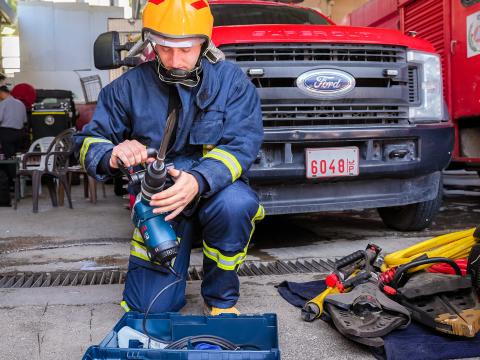Frontline Readiness: Supporting Firefighters in the West Bank

Riyad Jayousi, 38, is a dedicated member of the Palestinian Civil Defense, serving in one of the most vulnerable and volatile regions of the West Bank—Area C* of the Jordan Valley. For years, Riyad and his colleagues have been first responders when disaster strikes, working tirelessly to protect lives, homes, and farmland across remote and underserved communities.
The Civil Defense centres in Al-Jiftlik and Zbeidat serve as lifelines for the local population. Their mission is clear: reduce disaster risks, respond swiftly to emergencies, and strengthen the resilience of six surrounding communities—home to nearly 5,000 people. From wildfires fuelled by the valley’s arid climate to recurring episodes of violence, the threats they confront are both constant and complex.
Since October 2023, the situation in the Jordan Valley has deteriorated significantly. Escalating violence has resulted in the destruction of homes, agricultural structures, and critical infrastructure. Water systems have been particularly targeted. In this context, the need for rapid, well-equipped emergency response has become more urgent than ever.
Yet Riyad and his team face daunting challenges. The 30–40-minute journey from the main Civil Defense centre in Jericho often delays backup support. Fires—whether accidental or deliberate—spread rapidly in the dry conditions. Movement restrictions and ongoing violence further complicate their operations. However, their greatest obstacle remains a chronic lack of resources. Underfunded and poorly equipped, the team has often relied more on courage than on the tools necessary to respond effectively to emergencies.
In April and May 2025, World Vision provided both centres with essential firefighting and emergency response equipment. This vital support was part of a broader initiative—Rapid Response to Displaced & Conflict-Affected People in the West Bank—implemented in partnership with World Vision Ireland and funded by Irish Aid. The project focuses on strengthening local preparedness and resilience in high-risk areas like the Jordan Valley.
Alongside the equipment, 12 staff members and 22 volunteers received hands-on training to ensure the tools could be used safely and effectively. This training, also supported by World Vision, has significantly enhanced the Civil Defense teams’ capacity to respond swiftly and efficiently in times of crisis.
The impact has been immediate. In recent weeks, the new equipment has been used dozens of times to contain fires, safeguard farmland, and limit the damage during violent incidents. “These tools have made a real difference,” Riyad says. “In these difficult times, having the tools and training to protect our people is not just important—it’s essential for our survival.”
* The 1995 Oslo II Accord introduced a temporary administrative division of the West Bank into Areas A, B, and C, as part of a transitional arrangement pending a final status agreement. The Accord envisioned a gradual transfer of authority over all three areas to the Palestinian Authority. However, this transition never materialised. Today, the divisions remain in place: Area A (18% of the West Bank) is under full Palestinian Authority control, Area C (60% of the West Bank) is administered by Israel, and Area B (22%) remains under joint Israeli-Palestinian control.